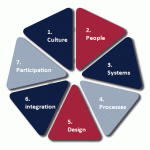 On 13th June 2017, 29 senior finance practitioners from such international and local companies as ABN AMRO, CRH, Diageo, Gemalto, Henkel, Ingram Micro, Naspers, PvH Europe, Regus, Sandoz, Staples Solutions, TIP Trailer Services, Vlisco, etc., gathered to interactively discuss Rolling Forecast Best Practices at the FP&A Board in Amsterdam.
On 13th June 2017, 29 senior finance practitioners from such international and local companies as ABN AMRO, CRH, Diageo, Gemalto, Henkel, Ingram Micro, Naspers, PvH Europe, Regus, Sandoz, Staples Solutions, TIP Trailer Services, Vlisco, etc., gathered to interactively discuss Rolling Forecast Best Practices at the FP&A Board in Amsterdam.
Rolling Forecast: Roll Beyond The Fiscal Year-End
In many companies the terms of budgeting, forecasting, planning are used interchangeably. But it is so important to understand the difference between all these terms.
Plan shows in detail how future will look like.
Forecast describes what the future most likely look like.
Target is an expression of an intent and desire.
Budget is allocation of resources
The important message from the discussion was that the forecasting is a management, not the measurement tool. It should not be connected with performance evaluation nor have any emotional attachment. However, it should only reflect what is likely to happen in the future.

Figure 1: Amsterdam FP&A Board Discusses the Best Practices in Rolling Forecasting
Traditional forecasting process often becomes part of target evaluation. It creates many inefficiencies and political games. As the result, forecasting process becomes ineffective and inefficient.
Traditional forecasting process is built around the accounting year. It does not give the visibility that is needed for planning the future. That is why the Rolling Forecast process is a better alternative as it looks beyond the year end.
So what is Rolling Forecast and why it can help an organisation respond to opportunities and threats in the marketplace, especially if it is operating in a dynamic and volatile business environment?
The Rolling Forecast simply means that each quarter or month, a company projects four to six quarters or twelve to eighteen months ahead. This way executives and key decision makers can see both financial and operational vision of the future. Moreover, it allows them to assess next steps in execution of their plan, understand critical pivot points in the plan and better judge the impact the economy may have on their plan. There are cases when Rolling Forecasts have replaced annual planning cycles with a continual planning process that resulted in more regular business reviews that look to the future. These reviews enable managers to understand problems, challenges and trends sooner and improve their proactive approach to those problems, challenges and trends.

The results of the research conducted by IBM back the above-listed conclusions. According to it, Rolling Forecast provides the companies with 12 percent more accuracy, they spend 50 percent less time on budget preparation and increase their profitability by 10 percent. That is a fascinating perspective, isn’t it?
Altogether, the Board moved on to consider all the hidden rocks and ways to steer away from them.
What Are The Key Factors For Successful Implementation of Rolling Forecast?
Giving better perspective and enabling flexibility, dynamic rolling planning and forecasting process provides better results over the traditional forecasting process. Implemented correctly, it expands planning horizons allowing not only anticipate change but also find the best ways to deal with the future risks and profitable outcomes. The seven factors for it successful implementation were previously discussed in the article Rolling Forecast: 7 Factors for Success.
Being discussed at the Amsterdam FP&A Board meeting, the seven factors shown on the figure below were commonly agreed to be crucial for successful implementation of the Rolling Forecast process.

Figure 3
Mini Case Studies From The Field
One of the fundamental principles of the FP&A Board work is looking into practical case studies. We were happy to have mini case studies from the field presented by Mirela Maric, Corporate Finance Director at Henkel, and Richard Reinderhoff, Strategic FP&A expert, who shared their first-hand experience and their case studies on Rolling Forecast Best Practices with the Board explaining how it can become the first step towards an agile business culture.

Figure 4: Group work at the Amsterdam FP&A Board (June 2017)
Group Work: Three Stages of Rolling Forecast Maturity
The Board members value the opportunity to network with their peers from the leading organisations. This time they enjoyed the group work devoted to key stages of Rolling Forecast Maturity. They actively discussed what is needed for the leading process from analytical, human and cultural aspects of the Rolling Forecast.

Figure 5: Three stages of Rolling Forecast Maturity
Speaking of the three stages of Rolling Forecast Maturity, the Board members agreed that the initial stage of Rolling Forecast is characterised by static planning: as it’s not driver-based it is also not flexible or dynamic. The level of analytics utilised is basic and descriptive. At the intermediate stage, the planning model is partly driver-based and has already moved away from the “too detailed” approach of the basic stage. However, static and inflexible planning systems are still partly in use. Consequently, it isn’t easy to generate fast-paced rolling forecasts on demand and to model different scenarios with ease. The leading stage is the Rolling Forecast’s most advanced level: the stage where all the potential of the process is realised through agile and prompt forecasting and planning, quick decision making and better corporate performance management.
The three stages of Rolling Forecast Maturity could be used by practitioners as a guideline for achieving the advanced state. As it was concluded in the article Three Stages of Rolling Forecast Maturity, when companies are ready to undergo the changes, they will realise all the benefits the smart implementation of Rolling Forecast could bring. Otherwise, it would become another non-value adding process, an expensive time-waster without benefit to the organisation. It should definitely be the company’s decision at which stage of its development they feel ready to move into the Rolling Forecast process.
Conclusions
The main conclusions of the third Amsterdam FP&A Board are as follows:
- Traditional Forecasting Process has many limitations that can be overcome by Rolling Forecast.
- Rolling Forecast is a better alternative as it gives better perspective and flexibility.
- Rolling Forecast is a “philosophy” and the company should be ready to this process.
- The key factor of success is culture that separates forecasting from performance evaluation.
- Successful Rolling Forecast should be driver based. It should be implemented through the system and involve key stakeholders and business units. Ideally, it should integrate three planning processes: operational, business and strategic.
- Rolling Forecast should allow for quicker and easy scenario planning and decision making process. If done properly, it can allow significant reduction of time spent on budget preparation or even can help to abandon the budget.
About FP&A Board
The London FP&A Board was created on 19th September 2013 to guide the development and promotion of best practices in financial planning and analysis (FP&A). Since then, FP&A Board chapters have successfully been established in 27 cities of 16 countries in Europe, the Middle East, Asia, Australia and North America.
Our Sponsors
We are very grateful to our sponsors and partners Michael Page, one of the world's leading professional recruitment consultancies, Page Executive, the global provider of innovative executive search solutions, and CCH Tagetik, the leading FP&A Technology company, for supporting the event.
Stay in touch with our global FP&A community through the FP&A Club LinkedIn Group and the FP&A Trends resource. Please do not hesitate to join and to contribute to the discussions, posts, and commentaries.





